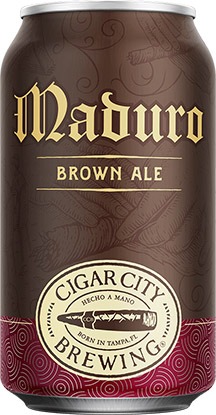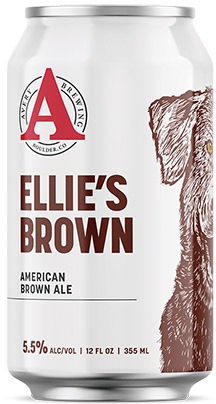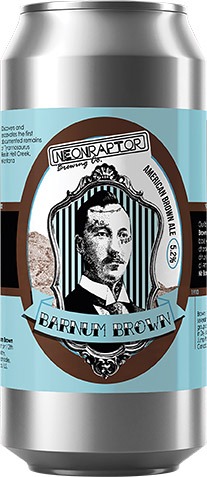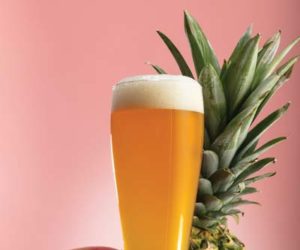Shades of Brown

I was born in Yorkshire, U.K., and have lived half my life in Newcastle, so brown ale forms a big part of my brewing DNA with Sam Smith’s Nut Brown Ale and Newcastle Brown being two of the biggest beers of my two home counties.
The history of brown ale goes back centuries; before the invention of pale malt in the 1700s all beer was brown, although there are arguments as to exactly how dark the beer from brown malt a couple hundred years ago was. For a little time after the invention of pale malt, brown ales continued to be made with 100% brown malt,1 but soon brewers realized just how much more efficient pale malt was and so brown ales began to be made from blends of brown and pale malt. Before you all go and decide to try and make a historic brown ale using 100% brown malt though, brown malt from that period was quite different from modern brown malt in that today’s version is fired to such a degree that it has no diastatic ability. Historic brown malt was kilned over wood and so had a smoky character with enough diastatic ability to be used at 100% of the grist.
In strives to be even more efficient brewers eventually ditched brown malt almost entirely, shifting to a base of up to 100% pale malt and added color to their beer with either caramel syrups or small amounts of roasted or crystal malts. While solely using caramel syrup to color brown ales has largely fallen out of favor, it should be noted the practice continues to be used by a small number of traditional brewers and even Newcastle Brown Ale was made this way until 2015.2
A pale malt base with crystal malt and roasted malt additions for coloring takes us to our modern understanding of the basics of a brown ale recipe. However, there was a divergence in the style, a divergence caused by the Atlantic Ocean that split the style into the two most common sub styles: The British brown ale and the American brown ale. (For the purposes of this article I’m not discussing London brown ale, as I feel that’s more its own unique offshoot — whereas American brown ales were an evolution of the British or northern brown ale.)
The first beer that described itself as an “American brown” was Pete’s Wicked Ale in 1986, but the style was formally codified in the first Beer Judge Certification Program (BJCP) style guidelines in 1997, which actually credits the style as an “adaptation by American homebrewers desiring higher alcohol and hop bittering levels to go along with the rich, malty character of all brown ales. Dark amber to dark brown color . . .” Not much has changed in this guideline over the years except the hop bittering: The current BJCP guidelines have both British and American brown ales at 20–30 IBUs, and while it states that American brown ales can have a medium hop aroma, it’s now an optional interpretation and the super-hopped browns are now categorized as brown IPAs.
It’s a blunt stereotype to say American brewers like their beers bigger, but there’s some truth to it. Give a beer style to an American and they’ll want it higher in ABV, packed with hoppy aroma, and when it comes to dark beers American brewers often make them darker, sweeter, and maltier. The original BJCP guidelines as much as says this outright — American brown ale became a style because of American homebrewers brewing instincts and personal tastes.
The BJCP style guidelines, however, set analytical boundaries and descriptions that brewers and particularly homebrewers gravitate towards following. The names are not a marker of where the beer is made — you get British brown ales brewed in the U.S. and American brown ales in the U.K. I would argue, however, that those same cultural drivers on style divergence have happened again. There is so much leeway in the guidelines that you could (and I will) make the argument that the two styles have effectively split into four: A British-American brown, an American-British brown, a British-British brown, and an American-American brown. Confused? Well come with me as we look at the ingredients set out in the BJCP guidelines and how brewers tend to approach them on either side of the Atlantic. We’ll also get some clone recipes supplied for some of the best examples of these styles.
Grain Bill and Mashing
British brown ales are specified as 12–22 SRM and an ABV of 4.2–5.4%. American browns are to style quite a bit darker and have a range with 18–35 SRM and a bigger ABV of 4.3–6.2%. Technically, then, when you have a beer at 18–22 SRM and 4.3–5.4% ABV it fits into both and could have a bit of an identity crisis, like Ozzy Osbourne when he sings in an American accent. This flexibility in the styles allows for what I’m talking about with the divergent approaches.
British-British browns will usually be the lower end of the SRM range, include 85–90% pale malt, with additions of brown, medium crystal, and Munich malts to make up the rest of the grist. You might even see a small addition of chocolate just to get it to the right color but not enough to impart any roasted character. American-British browns will rarely be the 12 SRM (usually pushing the 18), they’ll also be at the bigger end of the ABV, and chocolate malt is a lot more common and in higher quantities.
American-American browns will be strong, and will tend to push the color to porter levels of brown with higher amounts of chocolate malt (up to 10%) to achieve this. British-American browns will tend to be at the lower end of the American brown ale spectrum color-wise but will still need to use 3–4% chocolate malt or a lot of dark crystal to get up to the lower end of the American brown ale spectrum. All of these styles often use traditional English or American single-infusion mashes, as we’ll see in the following clone recipes.
Hops and Boiling
British-British brown ales tend towards British landrace hops like Fuggle and Goldings, but American-British browns can use American hops with similar earthy and floral aromas such as Willamette or Sterling. There should be just enough bitterness and aroma to balance the sweetness — this is not a hoppy style after all and the BJCP guidelines indicate 20-30 IBUs.
American browns have the same IBU range but hop character can have a lot more influence in this beer. The BJCP style guidelines are flexible on the matter though, saying that “some interpretations” of American brown ales are highly hopped; so Americans can be hoppy or not and still be to style. I’ve found that typically British-American browns tend towards the hoppy interpretation of the style. Any “American-style” for British brewers is associated with citrus-flavored, high-alpha hops so the likes of Citra®, Simcoe®, Cascade, or Ekuanot® would be appropriate whereas American-American Browns tend towards the more lower hop version and focus on malt character, using hops such as Willamette, Sterling, or Nugget.
Yeast and Fermentation
British brown ales should have some fruity esters built into the character. The BJCP guidelines say low to moderate, but for me, I want a characterful British yeast like White Labs English Ale (WLP002) or Mangrove Jack’s Empire Ale yeast. I want lower attenuation to again end with a higher final gravity.
American brown ales have a similar guideline of very low to moderate esters, so you can still use a more characterful yeast but I believe if you’re going for the more hoppy interpretation of the style then a clean finishing yeast such as the Chico strain would be ideal.
To get a clearer picture of all of this, let’s take a look at some clone recipes that came straight from the brewers to better understand ingredient selection and brewing methods for creating these brown ale variations.
Contemporary Brown Ale Clones
I asked my editor for recommendations of American brown ales that are popular in the states and Cigar City Brewing Co.’s Maduro was a suggestion. However when I looked this beer up I saw it was marketed as a “Northwest English” brown ale. So we’re going to slot this into the so-called American-British brown ale category.
I spoke to Wayne Wambles, Brewmaster at Cigar City, who told me when he traveled to the U.K. and tried Sam Smith’s Nut Brown he was disappointed and wanted to make a beer that truly had a nutty character and so he made Maduro. Since then, despite never meaning it to be an American brown ale, it’s been hailed as one of the best examples of the style and at competitions it actually tends to do best if entered as a brown porter.
This is far darker than the BJCP guidelines for an English brown and pushes past the upper limit in terms of ABV, but it shows you cannot contain American brewing culture behind the bars of strict BJCP styles, that irresistible urge to push a beer bigger and bolder will not be stopped.
Cigar City Brewing Co.’s Maduro Brown Ale clone

(5 gallons/19 L, all-grain)
OG = 1.059 FG = 1.017
IBU = 25 SRM = 32 ABV = 5.5%
Ingredients
8.25 lbs. (3.7 kg) Simpsons Extra Pale Ale Malt
1.4 lbs. (0.64 kg) Simpsons Crystal T50TM malt
1 lb. (0.45 kg) flaked oats
15 oz. (425 g) Briess Victory® Malt
11 oz. (312 g) Simpsons Brown Malt*
5.5 oz. (156 g) chocolate malt
5.1 AAU Northern Brewer hops (60 min.) (0.6 oz./17 g at 8.5% alpha acids)
3.9 AAU Willamette hops (15 min.) (0.7 oz./20 g at 5.5% alpha acids)
Wyeast 1335 (British Ale II), SafAle S-04, or LalBrew Nottingham yeast
¾ cup corn sugar (if priming)
*Be careful if substituting, at 170 SRM Simpsons Brown Malt is a lot darker than other brown malts. Coffee malt is an appropriate substitute.
Step by Step
Wayne suggested to mash a little higher than normal, so I’d mash in at 154 °F (68 °C); this will give you a higher final gravity and thicker mouthfeel. Mash the pale malt and oats for 40 minutes then stir in the crystal, Victory®, brown, and chocolate malts. Begin recirculation and slowly raise to mash out temperature of 168 °F (76 °C), hold for 5 minutes before beginning sparging.
Collect 6.5 gallons (24.6 L) wort in the kettle and bring to a boil. Boil for 60 minutes adding the hops according to the ingredients list. After the boil, give a long stir to create a whirlpool then let the break material settle. Chill down to yeast-pitch temperature, about 66 °F (19 °C). Aerate if using a liquid yeast strain and then pitch the yeast.
Ferment at 68 °F (20 °C) until terminal gravity reached, about one week. Condition for an additional week then transfer to a keg and force carbonate or bottle and prime to 2.4 v/v.
Partial mash option: Replace 6 lbs. (2.7 kg) of the extra pale malt with 3.5 lbs. (1.6 kg) of extra light dried malt extract. Place the extra pale malt, flaked oats, and Victory® malt in a large muslin bag then submerge in 2 gallons (7.6 L) hot water to stabilize at 154 °F (68 °C) and hold for 40 minutes. Add in the chocolate, brown, and crystal malts in a separate muslin bag and hold for 15 minutes. Remove both grain bags and place in a colander over the kettle. Slowly rinse the grains with 2 gallons (7.6 L) of hot water, then top off kettle to 6.5 gallons (24.6 L). With the heat turned off, stir in the malt extract. Bring the wort up to a boil and then follow the remainder of the all-grain recipe instructions.
Up next is what I’d call an American-American brown ale courtesy of Avery Brewing Co. Ellie’s Brown Ale is quite restrained in its color but a big addition of chocolate malt ensures a nutty, toffee, and lightly roasted character. This is definitely not the aggressively hopped version of an American brown; a slight amount of Sterling hops added late in the boil brings a slightly floral and spicy aroma to balance the sweetness. The London Ale yeast adds some fruity esters, but overall this is a beer that leans heavily into its malt bill.
Avery Brewing Co.’s Ellie’s Brown Ale clone

(5 gallons/19 L, all-grain)
OG = 1.056 FG = 1.014
IBU = 20 SRM = 24 ABV = 5.5%
Ingredients
9.8 lbs. (4.5 kg) 2-row pale malt
12 oz. (340 g) chocolate malt
10 oz. (285 g) Munich malt
6.5 oz. (185 g) crystal malt (120 °L)
3.5 oz. (100 g) melanoidin malt
3.8 AAU Bullion hops (60 min.) (0.5 oz./14 g at 7.6% alpha acids)*
1.6 AAU Sterling hops (30 min.) (0.33 oz./9 g at 5.1% alpha acids)
1 oz. (28 g) Sterling hops (0 min.)
White Labs WLP013 (London Ale), Wyeast 1028(London Ale), or Mangrove Jack’s M13 (Empire Ale) yeast
2⁄3 cup sugar (if priming)
*If you cannot find Bullion hops you may substitute with Nugget or Magnum.
Step by Step
Mashing the grains at 152 °F (67 °C) should be enough just to ensure you get that slightly higher final gravity. Mash all the grain together for 60 minutes before beginning lauter. Collect enough wort to boil for 60 minutes and obtain 5.25 gallons (20 L) of cooled wort in the fermenter.
After sparging, bring to a boil and boil for 60 minutes, adding the hops according to the ingredients list. After the boil, give a long stir to create a whirlpool and let the break material settle for 10 minutes. Chill down to yeast-pitch temperature, about 66 °F (19 °C). Aerate if using a liquid yeast strain and then pitch the yeast.
Ferment at 68 °F (20 °C) until terminal gravity reached, about one week. Condition for an additional week then transfer to keg and force carbonate or bottle and prime to 2.3 v/v.
Extract with grains option: Replace the 2-row pale and Munich malts with 5.4 lbs. (2.7 kg) of extra light dried malt extract and 8 oz. (230 g) of Munich dried malt extract. Add the chocolate, melanoidin, and crystal malts in a muslin bag and submerge in 4 gallons (15 L) of water as it heats up to 170 °F (77 °C). Remove grain bag, allowing to drip back into the kettle, then top off kettle to 6.5 gallons (24.6 L). With the heat turned off, stir in the malt extract.
Bring the wort up to a boil and then follow the all-grain recipe for boil and fermentation instructions.
Coming back to my side of the pond for what I’d call a British-British brown ale, Thornbridge and Bundobust’s collaborative Nut Brown Ale is an homage to the classic Sam Smith’s Nut Brown, the same beer that inspired Maduro, but you get a very different outcome. It is dark copper in color, with a grain bill all about building caramel flavor and a hint of chocolate malt for some of the darker toffee character, but not enough to add any roasted character. Eminently sessionable, this beer is designed for a long afternoon at the pub.
The recipe uses a slightly unconventional hop choice with Ernest, a British hop first bred in the late 1950s but never gaining mainstream appeal at the time due to its unpopular “American aroma” of apricot and citrus. With the popularity of such flavors in today’s craft beer landscape, Ernest has seen a recent resurgence.
Thornbridge Brewery & Bundobust Brewery’s Nut Brown Ale clone

(5 gallons/19 L, all-grain)
OG = 1.044 FG = 1.011
IBU = 25 SRM = 14 ABV = 4.3%
Ingredients
7 lbs. (3.2 kg) Maris Otter pale ale malt
1.5 lbs. (0.68 kg) Munich malt
5.3 oz. (150 g) crystal malt (60 °L)
2.6 oz. (75 g) brown malt
2.6 oz. (75 g) chocolate malt
6.9 AAU Ernest hops (60 min.) (1.25 oz./35 g at 5.5% alpha acids)*
4.5 AAU Ernest hops (hopstand) (1.6 oz./45 g at 5.5% alpha acids)*
White Labs WLP037 (Yorkshire Square Ale), Wyeast 1469 (West Yorkshire Ale), or SafAle S-04 yeast
1⁄2 cup corn sugar (if priming)
*If you can’t get hold of Ernest hops, Cascade hops would be a good substitute.
Step by Step
You don’t want as thick a mouthfeel for a British brown ale as you would for the previous examples, so mash in fairly low at 148–150 °F (65–66 °C). Hold at this temperature for 60 minutes and confirm the saccharification step is complete with an iodine test before proceeding to the lauter steps. Sparge with enough water to collect 6.5 gallons (24.6 L) in your kettle.
Boil for a total of 60 minutes, adding the hops at the times indicated in the ingredients list. At the conclusion of the boil, cool the wort down to 185 °F (85 °C) and then halt cooling and add the hopstand addition of hops. Stir the wort and let stand for 20 minutes before chilling to yeast-pitch temperature.
Ferment on the warm end of the yeast range, about 72 °F (22 °C), to coax all the fruity esters out of the characterful Yorkshire ale yeast. Bring down 54 °F (12 °C) after primary fermentation is complete for maturation of a week or so prior to packaging.
This kind of classic British-style ale would normally be served on cask or bottled conditioned. Keg if you must, but if you bottle condition you’ll get the best out of this beer. Add 1⁄2 tsp. of priming sugar to each bottle (or 1⁄2 cup for the entire 5-gallon/19-L batch) for low carbonation and serve at cellar temperature.
Extract with grains option: Replace the 2-row pale and Munich malts with 4 lbs. (1.8 kg) of extra light dried malt extract and 12 oz. (340 g) of Munich dried malt extract. Add the chocolate, brown, and crystal malts in a muslin bag and submerge in 4 gallons (15 L) as it heats up to 170 °F (77 °C). Remove grain bag, allowing to drip back into the kettle, then top off kettle to 6.5 gallons (24.6 L). With the heat turned off, stir in the malt extract.
Bring the wort up to a boil then follow the all-grain recipe for boil and fermentation instructions.
Our last recipe is what I’d consider a British-American brown ale, named Barnum Brown from Neon Raptor. This is a good example of the hoppy version of the American brown ale style you tend to see from British craft brewers. A grain bill that could well be a British brown ale, but the star of the show is the New World hops adding a big hit of pine, spice, and citrus. The Chico yeast ensures a clean fermentation that allows these big hop flavors to shine.
Neon Raptor’s Barnum Brown clone

(5 gallons/19 L, all-grain)
OG = 1.052 FG = 1.012
IBU = 18 SRM = 20 ABV = 5.2%
Ingredients
5 lbs. (2.3 kg) Golden Promise pale ale malt
2.5 lbs. (1.1 kg) Maris Otter pale ale malt
1 lb. (0.45 kg) crystal malt (60 °L)
8.3 oz. (235 g) Munich malt
8.3 oz. (235 g) brown malt
8.3 oz. (235 g) flaked oats
8.3 oz. (235 g) flaked barley
5 oz. (142 g) chocolate malt
5.6 AAU CTZ hops (60 min.) (0.4 oz./11 g at 14% alpha acids)
2.2 AAU Cascade hops (15 min.) (0.4 oz./11 g at 5.5% alpha acids)
9.6 AAU Cascade hops (hopstand) (1.75 oz./50 g at 5.5% alpha acids)
2 oz. (56 g) CTZ hops (dry hop)
2 oz. (56 g) Simcoe® hops (dry hop)
2 oz. (56 g) Centennial hops (dry hop)
SafAle US-05, Wyeast 1056 (American Ale), or White Labs WLP001 (California Ale) yeast
2⁄3 cup corn sugar (if priming)
Step by Step
You don’t want as thick a mouthfeel in a British brown ale and want the hops to be the star of this show for this beer, so mash in fairly low at 148–150 °F (65–66 °C). Hold at this temperature for 60 minutes. Proceed to the lauter steps. Sparge with enough water to collect 6.5 gallons (24.6 L) in the brew kettle.
Boil for a total of 60 minutes, adding the hops at the times indicated. At the conclusion of the boil, cool the wort down to 185 °F (85 °C) and then halt cooling and add the hopstand addition of hops. Stir the wort and let stand for 15 minutes before chilling to yeast-pitch temperature.
Ferment at 66 °F (19 °C). Add the dry hop addition after 3 days and then leave in for 7 days or until fermentation is complete (whichever is longer).
Bottle and prime with sugar or keg and force carbonate to 2.2 v/v.
Extract with grains option: Replace Golden Promise, Maris Otter, Munich, and flaked grains with 6.6 lbs. (3 kg) Maris Otter liquid malt extract. Place the crushed grains in a muslin bag and submerge in 4 gallons (15 L) as it heats up to 170 °F (77 °C). Remove grain bag allowing to drip back into the kettle, then top off kettle to 6.5 gallons (24.6 L). With the heat turned off, stir in the malt extract.
Bring the wort up to a boil and then follow the all-grain recipe for boil and fermentation instructions.
Story References:
1 Daniels, R. (2000) Designing Great Beers: The ultimate guide to brewing classic beer styles. Boulder, CO: Brewers Publications.
2 Knapton, S. (2015) “Newcastle Brown Ale recipe to change to keep America happy,” The Telegraph, 6 February 2015. https://www.telegraph.co.uk/news/science/science-news/11395877/Newcastle-Brown-Ale-recipe-to-change-to-keep-America-happy.html



